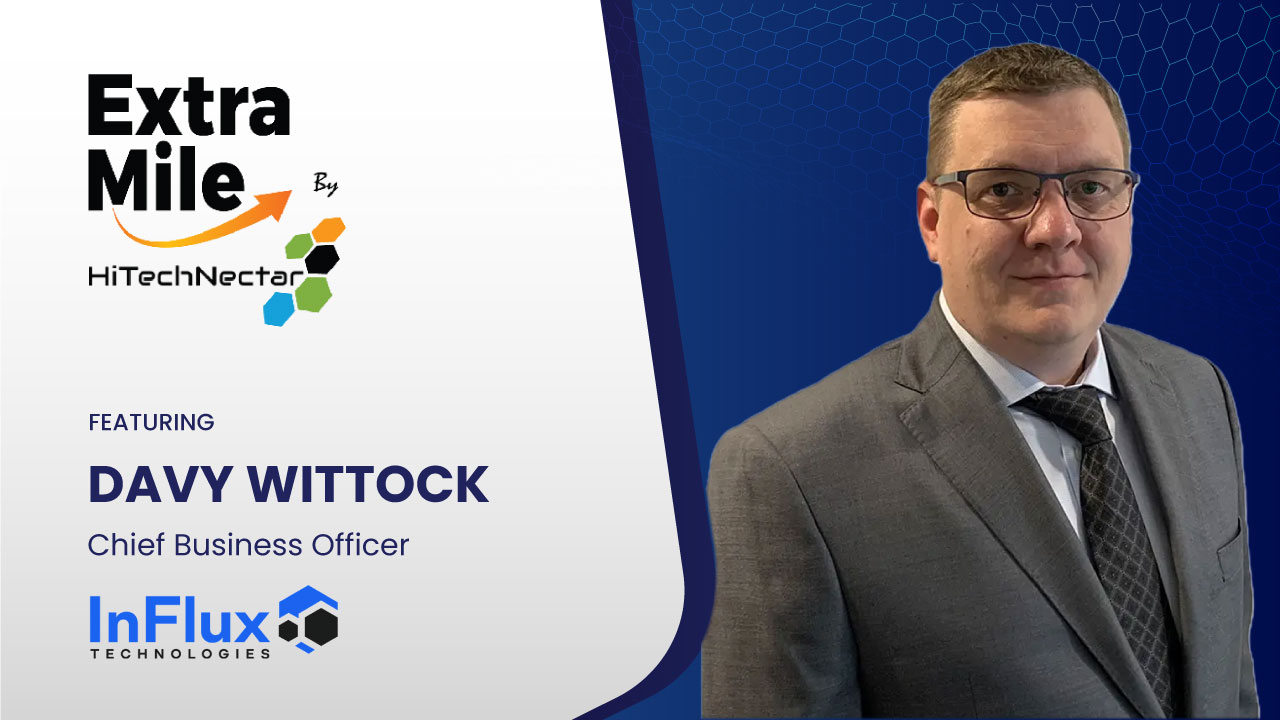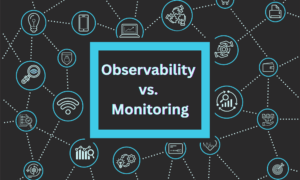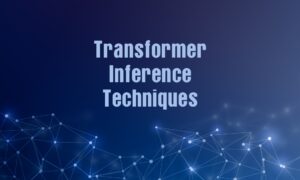Host: Hello everyone, welcome back to another episode of ExtraMile by HiTechNectar, an interview series that bridges the gap between the industry leaders and enthusiasts. I am your host Sudakshina, and we are here to discuss the latest innovation, tech trends, marketing practices, expert insights and a lot more. In today’s conversation, we are excited to introduce our guest, Davy Wittock, the Chief Business Development Officer of InFlux Technologies, the world’s first and largest Web3 and decentralized cloud computing company.
Davy leads the business development team and specializes in customer relationship management. He has a strong background in healthcare IT management, system performance analysis, architecture and enterprise solutions. Let’s discover his professional experiences and gain insights into the world of computer networking products.
Welcome, Davy. Greetings for the day. I hope you’re doing well.
Davy: I’m doing great. Thank you. That’s a great introduction.
Thank you.
Host: So before joining InFlux Technologies, you owned DNC IT Solutions INC and worked at MiFair. Can you share some key strategies or practices you implemented to ensure rigorous audits and maintain high standards of hygiene to protect patient data?
Davy: Oh, that’s quite the question straight away from the bat. Yeah. So as you can see, my background is medical IT and the biggest piece with medical IT is uptime, right?
We cannot be down and have patients in a hospital or a clinic and then having to tell them, hey, hold on, we’re rebooting the servers. That’s something that doesn’t fly. So for the last 20 years, my drive has been high availability, make sure everything keeps up and running.
And that goes from implementing all types of strategies, right? So the strategy first is, of course, making sure your end users know what to do and what to expect, even if there’s an outage. So it starts with training.
And then secondly, you start working with all the potential technologies that your vendors offer when it comes to the software you use. And of course, any type of implementation you do yourself. So especially when you start working with some custom implementations, then all of it falls on your shoulders to make sure it’s always available.
So things like active, passive type of environments, making sure you have a production environment and a test environment, making sure you have data that’s in the cloud or at least offsite to make sure that you don’t lose anything if something happens catastrophically at one of the data centers, so you have always a backup. So it’s been always my drive to make sure that nothing got centralized and there’s not one point of failure. So that was biggest drives for me, making sure we have systems in play with all sorts of sponsors to make sure that we do that correctly.
So, business type of sponsoring, that means the training piece, making sure your folks know anything about security, fising, all of that piece. And then on the technical side of things, working with the IT admins to make sure that we have an uptime that basically no doctor or patient, any hindrance of this. And we did a good job on this.
We followed like patch Tuesday, as they call it for Microsoft, when they released their new patching, we made sure that those got implemented ASAP just in case anything catastrophic happens on the patching side of things. We made sure we tested that first in our test environments. We did that with and work together with our vendors.
So, we were a very high demanding customer in that regard. And I was a very high demanding person when it came to that uptime, but I can vouch for basically 90.999% uptime for the things that we did. And then before that with Axa Healthcare, I was the person you didn’t want to see showing up at your hospital because that was at that point, unfortunately, something catastrophic was happening or there was some outages or delays and all that fun stuff.
So, it was my job at that point to find the needle in the haystack that was causing it. And then of course, prevention as well and making sure that uptime was guaranteed. So yeah, that’s been my driving factor for the last 20 years is making sure my systems are up and running at all times.
And I took that with me to Flux. So, kind of that thinking, that mentality, but then in a decentralized way. So that’s been my go-to so now.
Host: Great. That sounds really interesting. So, what inspired you to focus on decentralized cloud computing and BEP3 technology?
Davy: One of my pet peeves was that I always ended up talking with the same people. And that’s not a bad thing. These folks know what they’re doing, but I always felt that the cost was really high.
And like I said, you talk with the same people, so it’s not like there’s much alternatives out there. And so, I started looking for alternatives way back myself with the idea is always trying to find how do I make sure that I have no single point of failure. So to that regard, I would work with two vendors instead of just one way where most folks pick one vendor and stick with that vendor and they put all their trust in it.
We did the same, but I always had a second one as well, just in case. That came with the costs again. And so it got me thinking really hard.
And around 2017, 2018, I already was playing in the blockchain space. So, I was a miner, I was a pool operator. So, I was dabbling in the technology, trying to learn what that was all about.
And then I came across this project that was trying to focus on a decentralized infrastructure at that point, Flux at its infant stage. And it got me really intrigued. So I started working with them at that point.
And I quickly learned that that was still a young project. There was still some gotchas to it. But I quickly learned that this was something that the world was kind of looking for.
And we see that type of sharing your computes. We see that in the daily today with sharing your car. You basically do an Uber or you share your house, you do an Airbnb.
And Flux is kind of like that Airbnb type of thing where you basically unused compute space, you’re basically giving that to somebody else to utilize it and you get rewarded for it. I thought it was a really cool concept. So I basically reached out to the team, we started talking and I ended up working with them.
And here we are a few years later now, and I’m the business officer. So at this point, I’m trying to develop strategic partnerships, particularly in the tech and in the decentralized cloud compute space. So yeah, I love the innovation of it.
I love the opportunities that it’s going to give folks like you and I to make some extra cash, but at the same time, be completely decentralized and have less point of failures. And that’s the biggest drive for me.
Host: That was really great insights. It’s quite exciting to see how these technologies are evolving in future technologies. So would you shed some light on strategic planning and project management skills? How would you emphasize teamwork and project success?
Davy: Project managers are a special breed in my book. I love them and I hate them at the same time. And I think that’s the case for a lot of folks out there who have to work with them.
And I know from PMs, that’s how they often see themselves as well. They’re sticklers and I love that they’re sticklers. They’re the guys who take the heat when a project gets delayed and they never get the praise when a project is delivered on time, unfortunately.
And I’ve worked with a lot of PMs in my day so far. But some of the greatest ones that I’ve worked with, they were the ones who basically were able to put them behind the team and really push the team forward instead of trying to lead the team and dragging everybody with. And when a PM realizes the strength of his team or her team, and he’s able to push them forward with some guidance, but keeping them to the timelines, I’ve seen a lot of success in that regard.
And PMs basically able to take a step back and let the experts actually do the work properly and listening to the feedback and properly conveying feedback from your technical SMEs correctly to your customer or your partner you’re working with. I think that’s a big, big, big plus. I know everybody has their own style when they do PM and their strategy around it.
There’s hours upon hours of curriculum you can read up on. But from the day to day that I’ve seen, those PMs who really push somebody forward and really work with the skillset that these guys have, they seem to deliver versus those who think they need to know everything and want to know everything and take up a lot of time that way. Those are most often the projects that seem delayed, even though it’s with the right intentions.
As the PM, you’re not supposed to be the one who knows everything. As a PM, you’re supposed to be the one who drives it and leans on the technical skills. And yeah, that’s something that I’ve noticed in my day-to-days with the PMs. We’ve got some great PMs as well on our team. They each have their style and they each do it their way, but they seem to deliver. And that’s the great piece of it. At the end of the day, that’s the important piece.
Host: Make sure that you deliver and So, can you explain what a Flux Cloud is and how does InFlux Technologies reach the gap between the traditional Web2 and decentralized future Web3?
Davy: Yeah. So, the original Flux, as we stated a few times already, we started as a blockchain project, still is a blockchain project at the core. So, we use blockchain to help with standing up the nodes that folks like you and I can run.
So, we basically teach people how to run your own nodes with the intent that you can then run websites and the new Web3, or you can run game servers, you can use it for AI and all other fun stuff. But the blockchain is there to guide us and unorchestrate the applications that get deployed on the network. So, if you run your game server, you basically register that on the blockchain.
That sounds very technical. That was technical, but we made that all a lot easier and I’ll go to that in a sec. But the blockchain is there to take in the signature, make sure that it knows that there’s a new application being spawned.
So, you know your game server is coming online and then it propagates it to the network. The network will pick it up. One of the nodes will then spawn that application and report back to the blockchain saying, yeah, we’re good to go.
And you basically are up and running in a few minutes. You have your own game server running for pennies on the dollar. Now, I did say that used to be very technical and we can still go very technical on that as well.
But one of my driving pieces, my strategy for InFlux was to make sure that we cater as well to your everyday user. It’s great in the blockchain to produce awesome products, but if nobody’s using them, that’s kind of sad. And a big hurdle is adoption.
A lot of folks in the blockchain projects will talk about adoption. We took a step back. We said, look, we got all of these folks who come out of a Web2 space like myself.
We know what folks are looking for when we purchase products or services. Let’s make sure we implement that as well. So, one of the things that we did at the beginning of this year actually was allowing folks to utilize your regular day-to-day fiat currency.
So, you actually sign in with your single sign-on. So, you use Google, which is a very common signature approach. I think we do GitHub and GitLab as well, or you stay with the traditional Flux sign-in option.
But at that point, it looks and feels like any other provider out there. You sign in with your Google account, you pay with PayPal, you launch your server, and the backend, Flux takes care of the rest. We purchase the Flux.
We register it on a chain. None of that is something that you need to do. And that’s the biggest driver, I think, for a lot of folks.
And I apologize for the cat in the background here. But that’s one of the biggest drivers is ease of use. Folks don’t need to know that they’re on a Web3 environment or they’re on a Web2 environment.
They don’t care. They just want to be able to utilize it. And as a business developer as well, it’s my job to make strategic partnerships.
So, we have partnerships with Lumen in North America. We got partnerships with OVH. Those are your typical Web2 type of providers.
But they also see Web3 is coming, and they want to be prepared for it. So, they want to make sure that they partner with folks who are in the space who can teach them. And ultimately, they can utilize us as well.
So, they can run the same type of applications, but on our network via them. So, there’s Bricsys here, definitely already built. And I think the future is a hybrid model where you will have centralized entities working together with decentralized entities, providing a more inexpensive cost for you to run your websites, your WordPress sites.
To give you an idea, it costs you $5 a month for a fully decentralized WordPress environment. That doesn’t go down. That’s the beauty of it, right?
So, if one of your servers goes down, there’s two others ready to rock and roll, and it doesn’t cost you anything extra. And you can spin up a hundred if you like, if you really want to be redundant. But yeah, that’s the beauty of it.
Decentralization is coming, and decentralization is here, and it allows us to be less expensive, less points of failure, and a more transparent world as well, because you can literally see on the blockchain who’s paid for what, which is kind of cool.
Host: Absolutely amazing. So, what are some challenges that generally arise in transitioning from Web 2.0 to Web 3.0 technologies, and how would you suggest tackling such challenges?
Davy: Let’s take a step back. Let’s think about how folks were very hesitant on the cloud solutions before it even became a decentralized cloud. So, when I started having conversations, and I’m talking about 10 years ago, and even longer actually already, and I brought up cloud storage at one point as an offset to make sure that your data is not just on site, but you have a backup elsewhere.
At that point, it was still frowned upon. What do you mean the cloud? What’s the cloud?
It was a bad terminology in my book, cloud solutions. People thought it was just in the air. I explained to a lot of sponsors at that point that no, we’re just moving data off sites.
It’s stored elsewhere. It’s not in the sky as people were thinking of it. So, it was a lot of education at that point.
And to this day, I still know a lot of folks out there who still have nothing in the cloud, who still believe in tapes and discs. And every day, they take a backup, take the tape with them home. I’ve been there myself, but I’m talking back in 2005 at that point.
It’s tape storage. And I pray for everybody out there that they never have to use it to restore something because that’s a pain. So, going from Web2 to Web3 now, it’s kind of the same challenge.
And one of the pieces that I really focus hard on is making it so that it’s almost not a discussion point. So, having folks that think about, let’s say, a game provider, for instance, or a big game studio wants to use Flux. How would they go forward?
And we would have to talk about, hey, these are what we can offer. This is the cost. And one of the challenges you can put forward to any regular user of the cloud today is the cost.
Egress, ingress costs, those take up a lot of somebody’s budget on a daily just for that. And that goes for medical too. If you store medical data in the cloud, uploading it and downloading it when you need it is a costly endeavor.
So, cost is the definite point of talking. We can make it a lot more affordable. Then the question, of course, is how are you making it so much less expensive than the big players?
We talk about blockchain and how that works, but it’s a lot of education that goes into it. And then ultimately, with more education comes more thrust. And the moment you have trust build up, that’s where you start seeing a lot of adoption happening as well.
The same happened with clouds at the very start. There was no trust. So, people were very hesitant and they slowly, but surely got accustomed to it with products like Dropbox, Google Drive.
People slowly, but surely started accepting it. Now, the biggest driveway to regular companies is, okay, you can do the storage piece now in the cloud, but do you know where your data is? And that’s the next step for a lot of companies out there is that they did jump into the clouds, but they didn’t think further about the security piece of it.
And that’s one of the pieces that we’re fixing as well is that you basically get your own private clouds at that point, and then you do your own thing going forward. So, that’s a big driver as well. So, cost, security, scalability, all of those are the talking points when I’m talking with regular businesses.
And the more folks learn, the more trust will grow, and the more adoption will happen.
Host: These were really valuable insights. So, what trends in technology excite you the most right now? And how do you stay updated with these trends?
Davy: Of course, AI. AI is the topic for everybody out there. And I approach AI from a business side of things as well, again.
So, I approach it with the intent of how do we utilize it in a business sense, and how do we make sure, again, it’s decentralized if need be. Does it need to be decentralized? That’s a question by itself.
And then, of course, what type of models are involved? What type of hardware is involved? That got me going about two years ago already.
And I quickly came to the conclusion that for your everyday user, AI might always be a little out of reach. ChatGPT definitely was a big plus in that regard. But then, again, everybody’s flocking to that one product, not fully understanding the pitfalls of it.
And don’t get me wrong. The folks that created ChatGPT did an awesome job. It feels great.
It’s easy to use. The problem that I always have with it is that it’s one big company. You put your data in there, you don’t really control that data.
That’s always a concern. And so, with Flux, we basically created our own product called FluxEdge, and now FluxAI. And the FluxAI basically runs on top of FluxEdge, basically GPU compute, folks like yourself and myself providing it, all the way up to larger data centers that we bring new live into by literally using their GPU compute and provide it on the marketplace.
Now, our FluxAI product, similar to a ChatGPT, you can create your images on it. You can do your own text and prompting, but we have the option that it’s your data. It’s secure.
We don’t use it. We don’t have access to the data. And ultimately, you can even white label FluxAI and then use it in your own companies and use it internally.
And talking with a lot of companies out there, a lot of software developers as well, who use ChatGPT’s APIs, again, to help create other products or create it as a chat prompt and internally use it. But the biggest pet peeve is that if I upload my documents to it, what happens with that data again? So, a lot of folks are out there now looking to utilize their own open source products, but a lot of folks out there as well don’t really know exactly how to use it.
So, one of the things that we do with InFlux is as well as provide that type of training, that type of advisement to get your company basically up and running with the latest and greatest AI and how to utilize it, how to protect yourself, your intellectual property, protect that as well. Because what you hate to see happen is you upload your code base or whatever or your documentation, ChatGPT learns about it and now it provides it to your competitor, something you want to avoid. So, that’s what we’re trying to now as well roll out is create your own private cloud, even do it on-prem, roll out your own ChatGPT and your own open source one, and we teach people how to use it, how to implement it.
That’s the way forward for us. That’s what I’ve been really focusing on the last few weeks, months.
Host: Great, amazing, really dynamic innovations. So, how do you see the future of decentralized computing impacting businesses and individuals?
Davy: And I’ll add one more, governments as well. So, these are the three levels that I see happening. Individuals, you won’t probably always see it that you’re on a decentralized environment.
You log in, go to runofflux.com right now. It looks like any other website, but it’s running fully on a decentralized network. You don’t realize it, it’s happening.
So, for your end users, it’s not going to be that big of an impact personally, unless you actually participate in those pieces and you provide your own compute, then it’s a really big win for yourself. But the utilization itself, you’re not going to really notice this. It’s going to just be less expensive, which is a big plus, but the technology-wise is going to be in the backend, not on the front end.
When it comes to companies, however, it’s a bit of a different story. I think it’s going to be more of a hybrid solution for companies out there. You’re going to have databases and the question, of course, with the security of it, do you want to have that in the cloud or do you want to keep that more centralized?
The front end of all of these things, that’s a different story. You can definitely put that on a public cloud and have it interact with that database via APIs. So, companies are definitely going to start looking at it, especially, and then we’ve seen that already with Microsoft putting out announcements saying, hey, we’re not going to charge as much anymore for your egress, or we might waive it altogether, but it’s still up to them to make that decision.
What companies are looking for is ultimately saving costs, basically means more profit. And so, you’re going to start seeing them utilize the likes of Flux and other companies out there who do decentralized storage, for instance. That’s definitely a big push forward.
And at the same time, it creates less points of failure and that’s where a company is always important, right? Uptime is big. And then the last level is the governments.
So, governments out there, they still are struggling with this entire concept. What do you mean it’s in the hands of people like you and me? What does it mean regulation-wise and all that?
So, we definitely see some adoption coming on that end to the point even that even governments are starting to look at utilizing decentralized networks, again, for less points of failure, but also in less points of attack as governments then are dealing with other pieces, safer for businesses out there. Hacks is definitely a concern for a lot of folks. And decentralized options give more security that way as well, because even if one of these pieces goes down, there’s so many other ones that are still up and running.
And the U.S. government is interested in that. I’ve talked with Canadian governments, talked with some Indian governments at this point. So, on local levels and more government levels, there’s definitely an interest going forward.
And people seem to see that it’s something they should look into, learn about, as it will basically cover all the bases when it comes to security and the points of failures. Absolutely, right.
Host: So, what advice would you give to someone starting the career in the tech industry?
Davy: Well, that almost sounds like I’m talking to my kids. I got one who’s about to go into college. We have that conversation quite often.
The only thing that I teach my kids and everybody who asks for that type of advice is be willing to learn, right? My dad said that back when I was still in high school and college, he’s like, even though you get your diploma at the end of this course, you’re not going to be done learning. And I remember thinking, sure, dad, whatever.
Yeah, he was right. It doesn’t stop. When I got out of college, we didn’t even have proper Google yet, right?
So, Google was just a new fad at that point. People were starting to learn about it. And then the same that was the discussion today is about AI.
Same happened back then with Google. Oh, it’s too easy. It’s kind of kids are not going to learn anymore, blah, blah, blah, blah.
And I see that now with AI as well. School has blocked check GPT, for instance. Okay, I get it.
But you need kids to learn to adopt technology and not be afraid of technology. And we are so good these days at protecting and not at educating. And the protection is always with the right mindset.
But if you do too much protection, you basically cover. And at that point, you basically shield people from technology. So, anybody out there that I can give one word of advice, learn.
Even if it’s scary, learn about it. Get yourself educated. Get yourself up to speed on what the technology is.
You don’t have to understand it like an expert, but be able to at least grasp it so that you can have your own opinion on it, your own use case for it. And that’s how I teach my kids with AI, for instance. If they have to write an article on something, I have no issue with them using chat GPT or Flux AI in our case and ask them, hey, can you give me more information on this?
Can you give me some information on that? What are the pros and the cons? Use it.
If you can get more efficient with it, you should learn to use it. What I don’t like seeing, of course, is that, okay, now write me an article about all of these things and then sign off on it, send it off to the teacher and be done. Now you didn’t learn.
Now you learn to avoid things. So, in my book, it’s learning to use the technology correctly. Learn, learn, learn, never stop learning.
I meet folks in their 70s in the IT space and they’re still learning and they’re still enjoying it. That’s the way forward. Don’t be complacent.
Host: That was indeed great advice. So, thank you so much, Davy, for sharing your valuable insights and experiences with us. It was really a pleasure to host you today.
Davy: Absolutely. It was a pleasure being here. Thank you.
Host: Thank you so much. Thank you everyone for joining us.






















